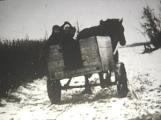10
I'm just thinking of the great changes that have taken place in the threshing and marketing of the grain. The first threshing outfits were small and the separator was fed by hand from one side; a band-cutter cut the bands of the sheaves with a sharp knife and moved them over to the man feeding the separator, and the straw was built into a stack as it left the straw carriers. The threshed grain ran into bushel measures and was emptied into cotton grain bags, then the grain was hauled away to the granary and the bags emptied. The threshing gang was made up as follows: two feeders, one band-cutter, two on the grain stack, two on the straw stack, one handling the bushel measures and another holding the bags; one hauling the grain away and another running the engine which burned wood, and yet another man to haul water for the engine.
11
Threshing Gang
1890
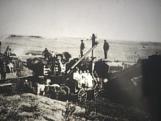
12
What a contrast to the modem threshing outfit made up as follows: two tractors, one sweep taking the stooks to the separator and four men, and threshing three times as much in a day. No filling and emptying bags, no tallying to do. In the days gone by, one threshing outfit would thresh out several districts; now there is an outfit on about every other farm. Changes have certainly taken place; labor saving devices are many. The outfit that threshed in this district one year (I think it was a little over thirty years ago), consisted of a large steam engine and separator, a caboose, a cook car. By the way, Dick Vesey was the cook. There were nine stook teams and nine teams hauling the grain to the granary and to the elevator. If I'm not mistaken there were three men in the field helping to load the sheaves, two spike pitchers helping to unload at the machine, one man running the engine and another feeding it straw. A separator man and a tank man made up the crew. That counted up to nineteen teams and twenty-eight men. The owner of the outfit paid for all the stook teams and all the men that went with the outfit. He boarded his own men and the farmer paid him for boarding the men that hauled away the threshed grain. Threshing started as soon as it was light enough in the morning and stopped at dusk; they stopped for dinner at eleven o'clock. They threshed 2,484 bushels of oats for me one morning and two of us emptied it into the granary from bags. We had no idle moments.
13
Train Station
1912

14
Before we got the railroad there was no market for our grain. What we had to dispose of after supplying our own needs was usually sold for seed to newcomers. After the railroad went through to Deloraine, grain merchants built grain warehouses at Cartwright and Holmfield and had men buying for them. The farmer had to fan his wheat and put it in bags and tie them, then when he got to the warehouse he unloaded on to a portable scale 8 or 10 bags at one time. After the grain was weighed it was emptied into a bin. The grades of wheat at that time were No.1 hard, No.2 and No.3; No.1, No.2 and No.3 frosted. A buyer would get on the wagon or sleigh, open a bag of wheat, examine the grain and make you an offer for it; another buyer would look at it and he would maybe offer you a cent more; we have sold No. I wheat for forty cents per bushel and have sold frosted wheat for twenty-three cents per bushel.
15
Buying goods at the store.
1905
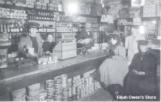
16
I have seen fresh eggs bought at the store at the rate of three dozen for twenty-five cents, butter 10 cents per pound, tomatoes three tins for twenty-five cents, two tins of red salmon for twenty-five cents, a pound of lobster for twenty-five cents, sugar five dollars per hundred pounds, good black tea three pounds for one dollar, and we have bought black tea of excellent quality from the Hudson Bay store in Winnipeg at twenty-one cents per pound by taking a chest of it. Work boots could be bought for one dollar and twenty-five cents per pair, overalls seventy-five cents per pair. It would seem to some of those reading this to be hardly creditable, but it is a fact nevertheless.
17
Wheat field in stooks
1884

18
Our first grist of wheat was taken to a flour mill at Glenora and a farmer got his own wheat ground into flour, and got all the flour, bran and shorts that he owned. After that we went to the Wakopa flour mill owned by Harrison Bros. and again I have made a number of trips to the Souris mill. The mill was equipped with the Hungarian Patent process and made an excellent grade of flour. Each round trip took four long days to go and return with oxen. The mill was kept running day and night, and if we were fortunate our gristing was done right away and we would be able to start for home without losing any time. The mill was owned by a man by the name of Gregory, and anyone that had to stay overnight was accommodated at his house. He had plenty of stable room and feed for the teams and the charge for man and beast was very reasonable.
19
Taking wheat to be milled.
1898
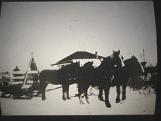
20
I remember Bob Blackwell and myself going with our grists to the Souris mill with the oxen and wagon after the freeze-up. The weather was lovely sowe travelled until quite late the first day and then camped out for the night. We had plenty of clothes with which to keep us warm. The next morning we hitched up early and got to Dunlop's for breakfast, (The town, Dunrea, is situated on that place now, or at least part of it). The townsite is on part of two farms that were owned by Dunlop and Ray so the town was named after the two farmers.
21
Travelling to a larger center.
1915
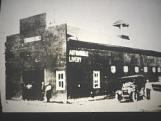
22
Leaving Dunlop's, we entered Lang's Valley and travelled it for a few miles, then crossed up the other side and the next valley we entered was the Souris and then on across the river to the mill. This time there were a lot of grists ahead of us and that meant staying at the mill two nights instead of one. We could get our meals at the house but there wasn't sleeping accommodation for all, so a number of us slept at the mill above the engine room which was nice and warm. We got loaded up and started for home before daylight on Saturday morning and travelled a good distance be- fore we stopped to feed our teams. After giving them a good feed we got going again. Bob said he intended to stay that night at a friend's and he would not resume the journey until Monday morning, but I decided to go on home after feeding and resting the oxen. I passed through the north end of Killarney late at night, and after a while began to feel sleepy so I wrapped a quilt about me and lay between the bags. I knew the oxen would keep to the trail so I dropped off to sleep. I don't know how long I slept, but when I awoke, I found the oxen both laying down. I got them going again and finally reached home before daylight on Sunday morning.
23
Mail Delivery
1905
